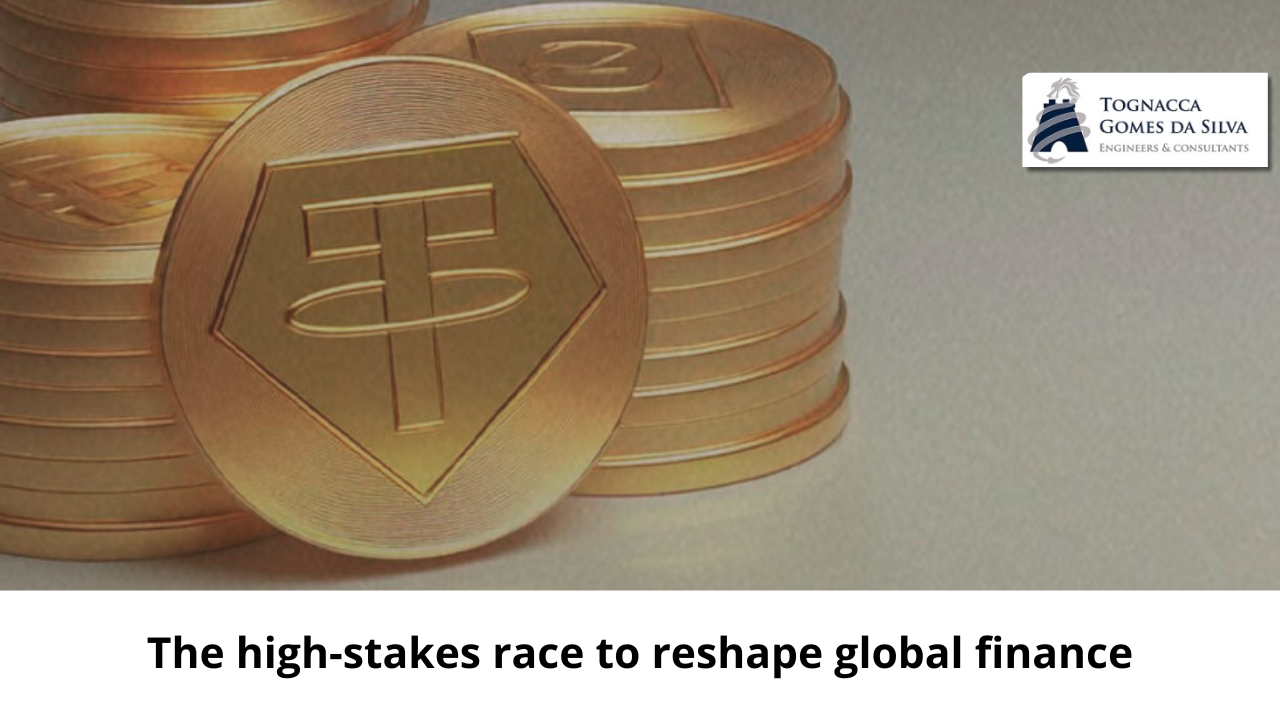Few financial innovations have garnered as much attention as stablecoins. Despite the volatility, hype, and turbulence associated with blockchain-based assets, these digital tokens, backed 1:1 by traditional currencies (usually the U.S. dollar), have quietly and sometimes controversially emerged as the bridge between traditional financial systems and the new world of cryptocurrencies. Stablecoins promise instant settlement, programmable payments, and global reach—raising the intriguing possibility that “software will eat the banks,” just as it has revolutionized commerce, media, and mobility.
But as these tokens spread, the battle for supremacy in the stablecoin market is intensifying. Crypto-native giants Tether and Circle are competing with banks, payments giants Stripe and PayPal, and a host of fintech challengers. Each of these players is not just looking to grab a slice of the stablecoin market, but to shape—or even control—the flow of money in the future. If software really can “eat” the financial industry, stablecoins could be the teeth of that transformation. But predictions of a single winner ignore the complexities of regulation, global finance, and the economics of business models. Indeed, stablecoins may end up looking a lot more like conventional money than disruptive crypto tokens—with multiple issuers, a web of regulations, and fierce competition that more closely resembles traditional banking than a war of tech platforms.
A second chance to restructure the financial system
From the perspective of entrepreneurs and technology developers, stablecoins offer a once-in-a-generation opportunity. For the past few decades, core financial infrastructures—bank deposits, international transfers, and card networks—have remained largely insulated from the full impact of the internet. Money may move a little faster, and online shopping has become commonplace, but the underlying system still relies on expensive intermediaries, frictionless compliance and reconciliation processes, and a patchwork of disconnected systems. Indeed, the “disruption” in banking and payments has largely been about new web and mobile interfaces overlaid on an entrenched infrastructure.
Stablecoins offer something different: fully interoperable, programmable tokens that can cross borders at the speed of data. And they look and feel like everyday currencies—dollars, euros, or pesos—rather than speculative assets like Bitcoin and Ether. This innovation is no mere incremental tweak. By pegging to traditional currencies, stablecoins mitigate the price swings that make it difficult to use other cryptocurrencies for everyday transactions or to build financial services (lending, insurance, payroll) on a blockchain. For crypto entrepreneurs, stablecoins represent an opportunity to create a new “operating system” for money—one that can replace slow bank transfers, outdated cross-border payment networks, and even card monopolies.
The potential for scale is enormous. Consider the global credit card networks: MasterCard and Visa process tens of trillions of dollars a year. If a dominant stablecoin network were to emerge—one that is truly global, with near-zero fees, real-time settlement, and interoperability across consumer apps and financial platforms—it could outperform these traditional giants. Stablecoins could also expand access to dollars in regions where economic or political constraints severely limit their use.
However, this scenario raises a number of regulatory red flags. Stablecoins, after all, manage reserves that can amount to tens or hundreds of billions of dollars. If these reserves are poorly designed or poorly regulated, they could intensify bank runs or destabilize domestic financial systems in emerging economies. They could also open up new avenues for money laundering or sanctions evasion—concerns that regulators take very seriously. The controversy surrounding Facebook’s Libra project, launched in 2019, which proposed a global stablecoin governed by a consortium of technology and finance companies, has clearly illustrated how authorities can move quickly to crack down on large-scale initiatives that stray too close to financial territory.
After regulators effectively dismantled Libra, stablecoins continued to surge forward — led by Tether’s USDT and Circle’s USDC. However, the Libra saga highlighted a significant risk: Stablecoins are deeply intertwined with the global financial system, and incumbents possess both the lobbying power and distribution reach needed to slow down or even co-opt new competitors.
Are we heading towards a platform war?
The prospect of a single, dominant, take-all stablecoin conjures up memories of iconic technology battles—VHS vs. Betamax in the 1980s, HD-DVD vs. Blu-Ray in the 2000s, or iOS vs. Android in the smartphone era. Often, each competitor tries to lock in consumers, developers, or apps in a race to achieve exponential network effects. The winning design then cements a near-monopoly until the next wave of technology comes along.
To be sure, stablecoins have some platform-like characteristics. If you own a stablecoin, you can quickly send it to almost anyone using a compatible blockchain or wallet. This interoperability is appealing: more liquidity and merchant acceptance leads to more users, which leads to even more liquidity, and so on. Tether’s market share has skyrocketed, fueled by early adoption in crypto trading circles. Meanwhile, Circle’s USDC has built a reputation for regulatory compliance and trust, gradually making inroads into DeFi (decentralized finance) applications, partnerships with traditional fintechs, and new payment initiatives.
But the stablecoin “Platform Wars” may follow a different script. The largest players in the stablecoin market have indeed built up brand recognition, liquidity, and strategic alliances, which in theory give them first-mover advantages. However, stablecoins have an inherent leveling force: they are all pegged to the same asset (the U.S. dollar or another fiat currency). Once regulations require stablecoins to be supervised in a manner similar to banks, these assets will become functionally identical. If each token is secure, redeemable on demand, and widely accepted, ordinary users will have no reason to worry about brand loyalty. Most people treat dollars held in different commercial banks as equally safe—why wouldn’t the same logic apply to stablecoins?
Why is a single winner less likely than you think?
Looking at the crypto ecosystem over the past few years, Tether and Circle appear to be dominating the market. However, stablecoins face four major obstacles that make it much less likely that a single clear winner will emerge:
1. Local regulatory pressures
When the Libra project was announced in 2019, central banks and finance ministers acted quickly. Although Libra has since been shut down, fears of a tech giant issuing a global currency—bypassing the traditional banking system—still linger. Indeed, governments are not willing to let “digital dollarization” proceed unchecked. Countries that enforce capital controls or have vulnerable financial systems will be especially vigilant.
Over time, this regulatory pressure will encourage the development of domestic stablecoins in each major jurisdiction. We have already seen this with the European Union’s Markets in Crypto-Assets (MiCA), which will likely push for euro-denominated stablecoins issued by banks and fintechs. A single global stablecoin that would outperform local issuers would pose a threat to the monetary sovereignty of countries. Instead, local stablecoins, regulated by national entities, will emerge.
2. Fragile Economics
Issuing a stablecoin, in and of itself, is not necessarily profitable. In the current high-interest environment, stablecoin issuers can generate revenue from the yields on reserves held in safe assets such as Treasury bills or money market funds. However, interest rates fluctuate, and some major currencies have spent years with near-zero or even negative rates. This dynamic undermines the idea that stablecoins can survive permanently on the yields on their reserves alone.
Other forms of monetization—such as redemption fees or transaction fees—are tricky. Users generally object to exit fees in payment systems and will not welcome stablecoins that do not allow free conversion back to fiat. This leaves transaction fees as an alternative, but enforcing them at the protocol level is difficult if the stablecoin issuer does not fully control the blockchain. So to be successful, stablecoin issuers often need a complementary business model—such as payments, merchant services, exchange platforms, or financial products that generate revenue.
3. Banks and payments giants won’t stand by
Traditional banks are in a unique position to issue stablecoins, starting with so-called “deposit tokens,” which offer all the advantages of stablecoins (programmable, fast-settling) while still allowing banks to operate with fractional reserves. If stablecoin issuance becomes a mainstream phenomenon, why wouldn’t a JPMorgan Chase or Bank of America leverage their existing relationships, compliance infrastructure, and deposit base to launch their own stablecoins? Credit card companies, meanwhile, could adopt stablecoin technology by partnering with multiple banks, preserving their crucial role in orchestrating payments.
4. Network effects less powerful than expected
Liquidity, which is highly valued in crypto, does not always translate into insurmountable network effects in consumer payments. Liquidity can disappear if major players change their strategy, and consumer preferences for “yet another stablecoin” can be volatile. As stablecoins become standardized and regulated, they may be seen less as specific brands and more as commoditized forms of money—interchangeable at will. This is exactly the scenario in traditional banking: from the consumer’s perspective, a dollar is a dollar, regardless of which bank holds it.
Path to a world with many stablecoins
From this perspective, the future of stablecoins points to a fragmented ecosystem of issuers. Some will be pure crypto specialists, others will be banks or regulated fintechs. There will still be tech or e-commerce companies with large user bases, converting loyalty programs into stablecoins. Paxos, for example, has specialized in the “infrastructure” for stablecoin issuance, helping partners like PayPal launch tokens under their own brands. Stripe recently acquired a startup specializing in stablecoin orchestration, reinforcing its belief that stablecoins can accelerate the global reach of its payments services and merchant solutions. In this scenario, stablecoins become a commoditized vehicle, while the real competition happens in the customer interface and distribution channels. Whether it’s your bank, your commerce platform, or your favorite app, this entity will become your primary access point for fast stablecoin payments. They can issue their own stablecoins or integrate multiple issuers behind the scenes. But in an era where these tokens are interoperable, the user probably won’t even notice which stablecoin they’re using. All they’ll see is dollars moving quickly and at low cost.
The role of regulation: catalyst or brake?
The point about regulation cannot be overstated. One reason stablecoins are viable is that they operate on open protocols—anyone can plug into their infrastructure. That’s great for competition and innovation. But from a regulatory perspective, stablecoins raise existential questions about monetary sovereignty, systemic risk, and legal compliance. Just as governments have restricted capital flows in the past, they may block stablecoin networks that they see as circumventing local laws or threatening domestic financial stability.
On the other hand, regulators also see potential benefits. Stablecoins are easier to track than cash, can reduce transaction fees, and can help maintain the global reach of the dollar, as long as they operate under U.S. oversight.
If regulators impose stringent conditions—such as requiring every stablecoin issuer to become a licensed bank—it will give traditional financial institutions an easier path to dominance in the industry. This could discourage open competition, which could lead to disruptive innovation.
On the other hand, if regulators find a balance between security and openness, we could see a variety of new entrants (fintechs, neobanks, crypto companies) joining traditional banks in issuing stablecoins. One current of excitement around stablecoins is their potential to “dollarize” large parts of the global economy.
If a stablecoin backed by the U.S. dollar spreads with little friction, it could become the primary store of value in countries with weak or volatile local currencies. But what may seem like a smart solution to escape an inflationary currency is, from the perspective of local governments, a threat to their monetary independence. Historically, countries have used a variety of tools—exchange controls, deposit restrictions, legal crackdowns—to prevent citizens and businesses from migrating to the dollar. Stablecoins will not be immune to these strategies. They may go unnoticed by some users, but widespread adoption would likely provoke retaliation.
The future: from one giant to many?
Is it possible that Tether or Circle, with their current scale, could still pull off a winner-take-all victory? In theory, yes — especially if they can navigate the regulatory landscape well and integrate deeply into merchant services, trading apps, and digital platforms. However, being dominant in the crypto ecosystem does not automatically mean winning the trust of mainstream consumers. Furthermore, regulators may grant direct banking licenses to stablecoin issuers only under strict conditions, limiting their profitability and forcing them to adopt a more conventional banking model.
In reality, the most likely scenario is the proliferation of stablecoins. Think about how people deal with money today: your paycheck might be deposited into a bank account, you might have a balance on a credit card linked to another financial institution, and you often use a digital wallet or payment service for everyday transactions. We rarely think about the mechanics behind these transactions because, by design, they are invisible. The future of stablecoins could be similar: a behind-the-scenes technology that enables instant, frictionless settlements between multiple issuers, each subject to regulations that ensure security and interoperability.
For this to happen, each stablecoin issuer will need a sustainable revenue model. This will almost certainly mean offering complementary services: payments, financial products, or deep integrations with a specific digital platform. Stripe’s recent acquisition of a stablecoin orchestration startup, for example, positions it to integrate stablecoins into its vast merchant network. Similarly, PayPal’s PYUSD stablecoin may not surpass Tether in circulation any time soon, but if it offers a more fluid and cheaper way for PayPal’s millions of users to send and receive money, it could generate substantial revenues in the future.
Disruption meets reality
Stablecoins have significant disruptive potential—enough to worry global banks, payment networks, and regulators. If they truly revolutionize the movement of money, they could fragment financial institutions, undermine traditional payment infrastructures, and expand access to stablecoins in markets that have long been starved of them. In this sense, stablecoins are truly the next frontier of the idea that “software is eating the world.”
However, we shouldn’t expect a single stablecoin to become the universal operating system of money. As these assets move beyond crypto niches and face real-world challenges—licensing, capital requirements, competing issuers, and the complexity of global politics—the landscape becomes more complex. The more stablecoin issuers are required to safeguard reserves and comply with diverse regulations, the more their products will become similar.
Ultimately, stablecoins could triumph in making programmable, instant payments a universal reality, even if no single issuer dominates the market. The deeper battle will then be over who will control our digital wallets and who will own the direct customer relationship. Banks, technology platforms, and payment networks are betting that stablecoins will be the financial connectors of the future. Crypto-native challengers are hoping to break the hold of these incumbents. Meanwhile, regulators are determined to ensure that these new approaches do not undermine financial stability or undermine governments’ ability to monitor and control money flows.
It’s a high-stakes race with no guaranteed winner, but one thing stands out: once stablecoins achieve significant traction, they will be extremely difficult to eradicate. Even if each coin functions as “just another dollar,” the underlying transformation—the ability to instantly transfer money across borders, integrate new types of financial services, and operate on open protocols—is too profound to ignore or reverse. And regardless of who prevails — Tether, Circle, PayPal, Stripe or JPMorgan — consumers and businesses will finally see the disruptive force of the internet applied to the heart of the financial system.
( fonte: MIT Technology Review)



